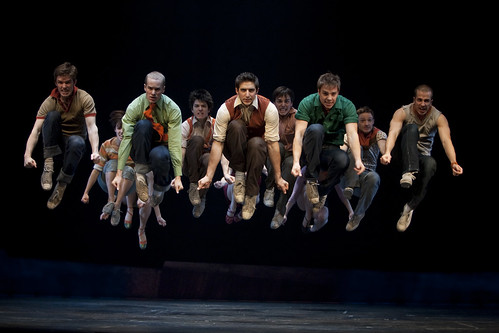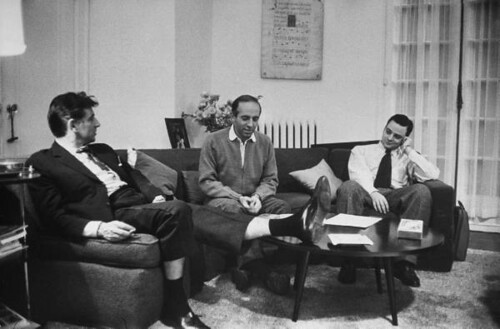Just play it cool, boy! The enduring sound of West Side Story
The Jets take flight to Leonard Bernstein's score in the 2009 Broadway revival of West Side Story. Photo by Joan Marcus. Below, Leonard Bernstein, further below from Life magazine in 1956: Collaborators Bernstein (left), Jerome Robbins and Stephen Sondheim discuss the imminent opening of West Side Story. Photo by Alfred Eisenstaedt © Time, Inc.
What makes West Side Story so incredibly intoxicating, even 53 years after its premiere? There's no denying the power of Jerome Robbins' athletic and gorgeous choreography or the simplicity and (occasional) corniness of Stephen Sondheim's lyrics (his first for a Broadway show). And Arthur Laurents' book, which puts a 1950s spin on Romeo and Juliet, is about as solid as Broadway books come.
But it's the music, Leonard Bernstein's astonishing music, that elevates West Side Story to legendary status. Combining classical with jazz with show tune, Bernstein concocted a highly original sound that has yet to be bested on the Broadway stage. This is a score for the ages, one as equally at home in the symphony hall as in the high school auditorium. How many scores can fit as comfortably in both spaces? Aside from Bernstein's own Candide (which he was working on in tandem with West Side Story), not many.
We'll have the chance to revisit the score this week as the most recent Broadway revival comes to town as part of the SHN/Best of Broadway series.
Patrick Vaccariello is the music supervisor and musical director for the revival, which opened on Broadway in March of 2009 and is still running at the Palace Theatre. He helped get the tour in shape and comes to West Side Story – his first Bernstein show – having worked on musicals ranging from Jesus Christ Superstar to The Boy from Oz as well as the most recent revivals of A Chorus Line and Gypsy.
Having been immersed in the world of Bernstein's music for nearly two years now, Vaccariello says one secret of the Bernstein score's power is the way it supports the emotions of the characters.
"It's my job as the musical director to convey the emotion to the musicians so they're fully supporting the actors," Vaccariello explains on the phone from his New York home. "The characters on stage are passionate people. From the fanfare and the prologue to the finale, we all take an incredible musical journey each night, and that journey is fully supportive of the action on stage. We use the original orchestrations – by Bernstein, Sid Ramin and Irwin Kostal – which are thrilling."
When the revival opened, the orchestra included 29 pieces. That has since been reduced by four. And for the tour, the pit will hold 19 musicians plus the conductor, which is still pretty large for a traveling show. "A lot of Broadway shows have synthesizers," Vaccariello says. "We have violins and cellos, so you get the emotion. When violinists play a melody, it's thrilling."
The musical director, being the arbiter of the musical emotion, is able to react directly to what the actors are putting out there on stage.
"We can shape the show differently every night," Vaccariello explains. "For instance, in the balcony scene, when Tony and Maria are singing 'Tonight,' they play it slightly different every night with different dynamics. I can try and match that by bringing out the woodwinds or shaping a phrase slightly differently. Everything in this show is heightened, and the beauty of the Bernstein score is that it energizes the performances."
In addition to grand symphonic pieces like "Somewhere" or "Maria," the orchestra also gets to cook with numbers like "The Dance at the Gym" and "America."
Vaccariello calls the "Tonight" quintet one of the "most amazing pieces of musical theatre ever" because, as he says, "it's purely about the acting and the singing and gorgeous lyrics."
And in this production, directed by Laurents (who was 91 when the revival opened), the Puerto Rican gang known as the Sharks, sings in Spanish. "That adds a whole other layer of emotion," Vaccariello says.
Broadway audiences unfamiliar with the show were somewhat baffled by the Spanish lyrics (translated by In the Heights' Lin-Manuel Miranda), and as the production went on, some of the Spanish was turned back into English.
"We didn't want audiences new to the show confused by the story," Vaccariello says, "so we put a few bits of English back in. But there's still plenty of Spanish."
Bernsteins' score for West Side Story raised the bar for Broadway musicals. The show integrated book scenes with songs and dancing in a seamless way that was groundbreaking and still sets the musical theater standard.
"Many new composers would love to write like Bernstein," Vaccariello says, "and many try. His work is a great learning tool. And it never gets old or dated."
Hearing the score 50 years later, Vaccariello says, "feels like hearing it for the first time."
Here's a peek at Bernstein conducting "Dance at the Gym" for the 1985 studio recording of West Side Story.
FOR MORE INFORMATION
West Side Story opens Wednesday, Oct. 27 and continues through Nov. 28 at the Orpheum Theatre, 1192 Market St., San Francisco. Tickets are $30-$99. Call 888 746 1799 or visit www.shnsf.com for information.


